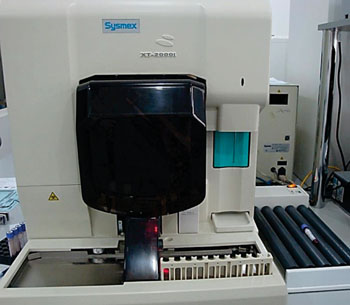Diagnostic Predictive Value of Platelet Indices Evaluated
By LabMedica International staff writers
Posted on 31 Aug 2016
The two main causes of thrombocytopenia excluding pseudo thrombocytopenia are increase destruction or peripheral consumption also known as hyper-destructive thrombocytopenia. Decreased platelet productions or hypo-production thrombocytopenia are associated with a number of bone marrow diseases.Posted on 31 Aug 2016
The gold standard method for discriminating the causes of immune thrombocytopenic purpura (ITP), disseminated intravascular coagulation (DIC), and thrombotic thrombocytopenic purpura (TTP) is bone marrow examination. Due to its invasiveness and being unfriendly for the patients, this procedure is not recommended as first line diagnosis. ITP still remains a diagnosis by exclusion due to lack of accurate clinical and laboratory parameters.

Image: The XT 2000i fully automated hematology analyzer (Photo courtesy of Sysmex).
Hematologists at the College of Health Sciences (Addis Ababa University, Ethiopia) conducted a prospective cross-sectional study on 83 thrombocytopenic patients whose platelet count was less than 150 × 109/L. From these, 50 patients had hypoproductive and the rest 33 had Immune Thrombocytopenia Purpura (ITP). Age and sex matched 42 healthy controls were included as a comparative group. Bone marrow examination was performed in all 50 hypoproductive patients and in 10 of the 33 ITP patients as part of their medical follow up and diagnosis. Females were the predominant study participants in ITP patients, while males were predominant in the hypo productive group.
Blood sample for complete blood count (CBC) analysis was collected into 5 mL EDTA anti-coagulated tube and CBC analysis was performed using the XT 2000i fully automated hematology analyzer (Sysmex Corporation, Kobe, Japan). This analyzer measures white blood cells (WBC) and reticulocytes with an optical detector block based on the flow cytometry principle, red blood cells (RBC) and platelet counts are analyzed via the impedance method. The performance of the instrument was monitored by running quality control materials. A peripheral blood smear was also reviewed to estimate platelet counts, rule out pseudo thrombocytopenia and fragments of cells like shistocytes.
All platelet indices were significantly higher in ITP patients than in hypoproductive thrombocytopenic patients. In particular mean platelet volume (MPV) and Platelet Large Cell-Ratio (P-LCR) have larger area under ROC curve, 0.876 and 0.816, respectively, indicating a better predictive capacity, sensitivity and specificity in discriminating the two causes of thrombocytopenia. The indices were still significantly higher in ITP patients compared to 42 healthy controls. A significant negative correlation was observed between platelet count and platelet indices in ITP patients.
The authors concluded that Platelet Distribution Width (PDW), MPV, and P-LCR help in predicting thrombocytopenic patients as having ITP or hypoproductive thrombocytopenia. If these indices are used in line with other laboratory and clinical information, they may help in delaying/ avoiding unnecessary bone marrow aspiration in ITP patients or supplement a request for bone morrow aspiration or biopsy in hypoproductive thrombocytopenic patients. The study was published on July 1, 2016, in the journal BMC Hematology.
Related Links:
Addis Ababa University
Sysmex














